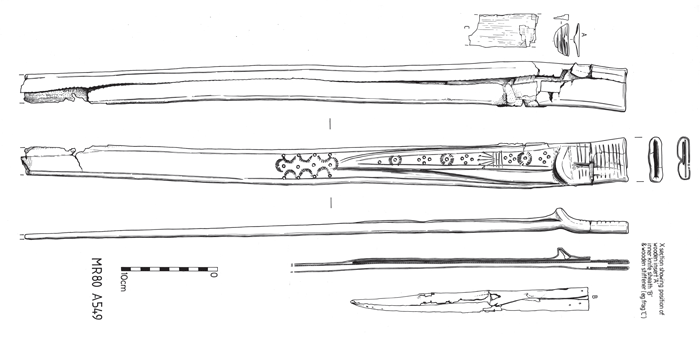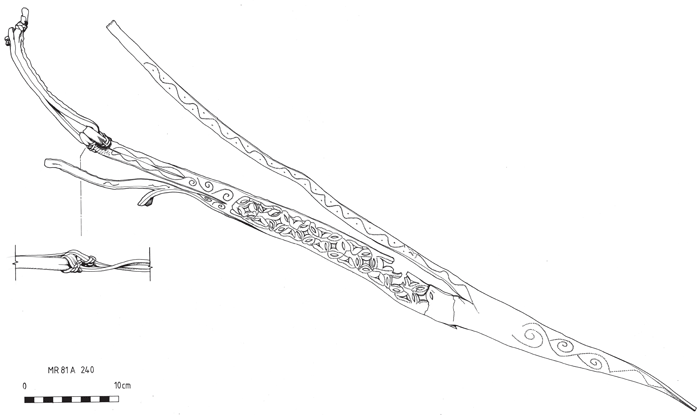| Author |
Message |
|
Gregory J. Liebau
Location: Dinuba, CA Joined: 27 Nov 2004
Posts: 669
|
 Posted: Sun 14 Oct, 2012 7:48 pm Post subject: Posted: Sun 14 Oct, 2012 7:48 pm Post subject: |
 |
|
| Jeremy V. Krause wrote: | | I just see historically accurate designs tooled in leather as a valid avenue in historically based scabbard making (1000-1300) especially when done in a way emphasizing historic, not modern design sensibilities. |
Hello Jeremy,
It really comes down to how much detail someone is willing to extrapolate from the evidence. As it stands, we don't really have any surviving sword scabbards from the period 1000-1300 that do incorporate more than a few incised lines or possibly some very basic and small designs. I can't say I've looked at them all lately, but in general this holds true. Period artwork depicting scabbards really doesn't help the matter at all, as manuscript marginalia and illustrations and stone sculpture (which has to be tooled in order to achieve anything) almost never contain enough explicit details to be sure of what they're representing.
On the other hand, some of the artwork does clearly show designs on scabbards. We can assume that paint and/or tooling was used to create these designs in reality. With what evidence I have before me, paint is by far the safer route. I have two reasons for this. The first is obviously the presence of painted sword scabbards, such as the example I discussed on the first page. The second is the fact that parchment was a popular material for covering scabbards and thicker pieces of leather were apparently not. Parchment is more akin in its qualities to paper than heavy leather, and will not take tooling in the same way we expect to see it on knife scabbards, which are made from a different material.
Please keep in mind that I'm considering mainly 13th century examples to make my points. I can't speak for earlier stuff, as that's a topic I have not dealt with. I'm also presenting information based on a rather poor body of specific evidence, so I'm certainly not infallible. I do, however, enjoy erring on the side of caution and taking what evidence we have at face value. The knife sheaths and hints of tooling on scabbards, such as the light lines incised on King Sancho IV's, are compelling, yet I admit it does not add up to enough for me to justify saying 'yes, scabbards during the High Middle Ages could be heavily tooled."
Cheers!
-Gregory
|
|
  |
 |
Blaz Berlec

|
|
   |
 |
Sean Flynt

|
|
   |
 |
Sean Flynt

|
|
   |
 |
Sean Flynt

|
 Posted: Fri 09 Nov, 2012 8:22 am Post subject: Posted: Fri 09 Nov, 2012 8:22 am Post subject: |
 |
|
Mary Rose scabbards and belt. These are on the + side of your dates, Chad, being second quarter of the 16th c., but these are very useful drawings. They show relatively crude decoration. The scabbard with the star at top might even have been decorated/personalized by its owner as a pastime, as soldiers have often done over the centuries (my observation, not the Mary Rose Trust's).
 Attachment: 52.77 KB Attachment: 52.77 KB

 Attachment: 36.79 KB Attachment: 36.79 KB

 Attachment: 32.28 KB Attachment: 32.28 KB

-Sean
Author of the Little Hammer novel
https://www.amazon.com/Little-Hammer-Sean-Flynt/dp/B08XN7HZ82/ref=sr_1_1?dchild=1&keywords=little+hammer+book&qid=1627482034&sr=8-1
|
|
   |
 |
Roland Warzecha

|
 Posted: Sun 02 Mar, 2014 3:55 am Post subject: Posted: Sun 02 Mar, 2014 3:55 am Post subject: |
 |
|
Here are some photos of a surviving painted scabbard, probably from the 13th century. As you can see from the old illustration, the scabbard was originally much longer, and only after a "repair" received its actual shape, apparently in modern times.
Regarding tooling of scabbards:
There are numerous finds of leather fragments from sword scabbards from Schleswig, Germany, and Leiden, Holland, mostly from the late 13th and 14th century, that had been decorated with impressed lines or ornaments and ocassionally stamping. The artistic quality is nowhere near as elaborate as that seen on contemporary funeral brasses, but that does not mean that the latter did not exist. The archeological finds are believed to be pieces of older scabbard leathers that had been cut from the wooden core and discarded, in order to re-use the wooden corpus and eventual metal fittings.
It seems plausible that more appeallingly ornamented leather may eventually have been re-used for other purposes, although this is just speculation.
In any event, the afore-mentioned finds show that tooling was by no means rare, although the bulk of scabbard leather finds was plain and without any decoration.
Here is a reconstructed scabbard decoration I made for one of my swords. You can see a drawing of the original find from Leiden next to it.
All the best,
Roland
|
|
  |
 |
|
Gregory J. Liebau
Location: Dinuba, CA Joined: 27 Nov 2004
Posts: 669
|
 Posted: Mon 05 Mar, 2018 9:20 pm Post subject: Posted: Mon 05 Mar, 2018 9:20 pm Post subject: |
 |
|
Since this topic stumbled back into my line of sight, it seems an appropriate place to say that an English translation of an article about a large number of scabbard remnants found at Leiden has been made available from the local university. I don't know how to link the file because it just keeps loading as PDF when I click Sean's link, so I'll direct interested parties to the appropriate thread at the Armour Archive:
http://forums.armourarchive.org/phpBB3/viewto...p;t=187300
As Roland suggests, a majority of these finds bear relatively simplistic decoration in the form of carvings, but the more elaborate ones can be appreciated as inspiration for some of the finer scabbard reproductions that are being made by craftsmen today.
Cheers!
-Gregory
My Flickr Galleries - Travel, Nature & Things
|
|
  |
 |
|
|
You cannot post new topics in this forum
You cannot reply to topics in this forum
You cannot edit your posts in this forum
You cannot delete your posts in this forum
You cannot vote in polls in this forum
You cannot attach files in this forum
You can download files in this forum
|
All contents © Copyright 2003-2024 myArmoury.com — All rights reserved
Discussion forums powered by phpBB © The phpBB Group
Switch to the Basic Low-bandwidth Version of the forum
|

